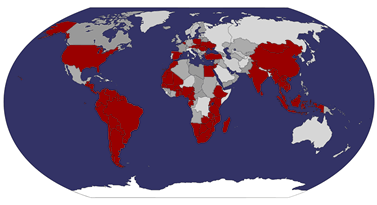We got in late and stayed in a cheap hotel near the bus station (but hey, it was clean and we had our own bathroom, so I can´t complain). The next morning, we took the city bus to Ponta Negra, the beachy part of town 12KM (45 minutes or so--slow bus) away.
It was OK, but very urban--really built-up all along the beach, very crowded, and in one part, with some water draining from town that smelled suspiciously like sewage. Despite the cool-looking giant sand dune, on which people used to sand-ski, and the cheap coconut water (75 centavos, or about 35 cents US, for a coconut), we didn´t stay long.
Instead, we took a bus to Praia de Pipa, a beach town 85 KM (and, on another very slow bus, a frustrating 2+ hours) south. It had been recommended to us by a Brazilian we met at the Lencois Maranhenses, and we are really glad we went, because it was lovely.
The town there was also rather built-up and touristy (with crazy high restaurant prices to match), but because all of that is on a cliff and the beaches are downhill from that, they are still in a very natural setting.
There were some good amenities in town, like this temple...
...and the hairdresser´s, where Andy got his second haircut of the trip (price with tip, 12 reais, or about $6 US). The hairdresser even spoke a little English!
Thanks to the slow transportation and our schedule, we had very little time in Pipa, just from 4PM one day to 8AM the next day, but we managed to explored three beaches in the area in that time.
Our best excursion involved two things I normally hate--waking up early, and hiking--but it was really worth it when we got to swim at a totally deserted beach AND see dolphins cavorting really close to the shore (which was what we had really hoped to see when we set out at 6AM to shlep there).
It is SO hard to get a picture of a dolphin out at sea, but if you look closely you can see one´s fin sticking out of the water here on the left. Andy is really proud of this picture. =)
He also took this one of a big crab on the beach.
After our best Brazilian buffet breakfast yet (another post!), we hauled butt out of Pipa on a minibus that took us (again, verrrry slowly) 25 kilometers to the town near the highway. Determined not to have to backtrack another hour to Natal, we flagged down a southward-bound bus to the nearest city, Joao Pessoa. (This is one of the crazy things you can do--flag down a fancy bus from the side of the highway, even though you don´t have a ticket. This is what slowed down many of our bus trips in the area, but we were pretty pleased at the practice when we finally needed to do it.)
We changed buses in Joao Pessoa for Recife and arrived there in the afternoon. Sadly, this only left us 2 hours or so to explore the city before we had to get on the night bus to Salvador, but we made the most of our time there.
Downtown Recife has a lot of beautiful old and colorful colonial buildings, like this one.
And many very old churches on little squares. As you can see, much of downtown was completely deserted, like a ghost town. It was Sunday afternoon, and since we always seem to be arriving in a new city on a Sunday, we have noticed that this happens in a lot of places.
Sunday is a bad day for going inside churches, but a good day to Jew it up! Recife has the archeological remains of another site that claims to be the "oldest synagogue in the Western hemisphere," so of course we had to go.
Irony of ironies, it is located on a street that is now called "Street of the good Jesus." Back in the day, it was known as "Street of the Jews."
Inside was an exhibit with info about Dutch religious tolerance, the immigrant Portuguese Jewish community in the 1600s, and how the Portuguese eventually threw the Jews out. Some of them went to New York, some went around the Caribbean (like to the other first synagogue in Suriname?).
There were remains of a mikvah-like well and some other archeological findings under glass on the ground floor, and a newer synagogue on the upper floor:
After our temple visit, we got some sausage on a stick (yes, more irony), and that was about all the time we had in Recife. Next post should cover our adventures in Salvador. Keep the comments coming!

